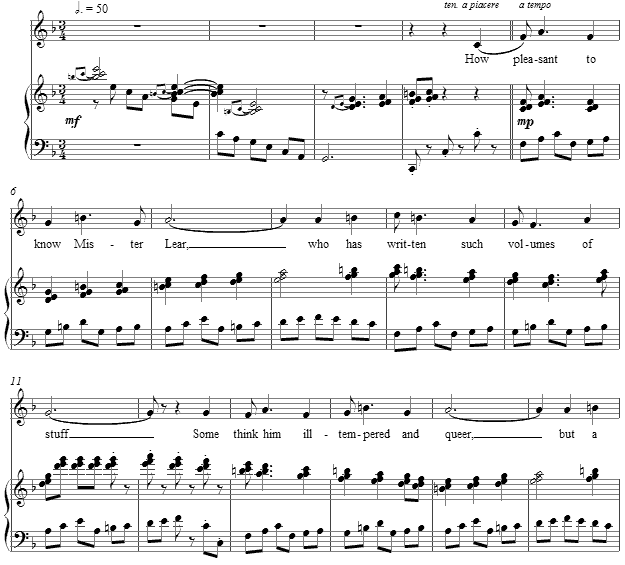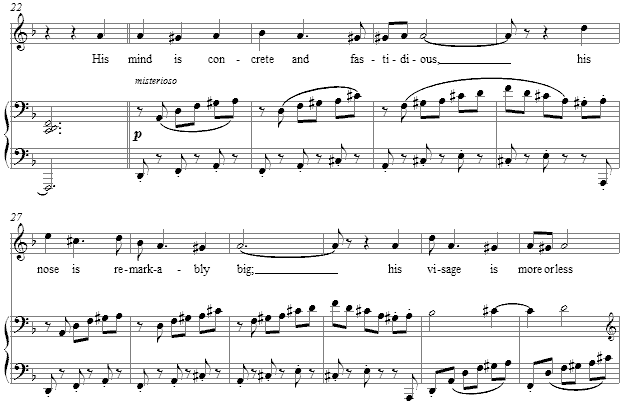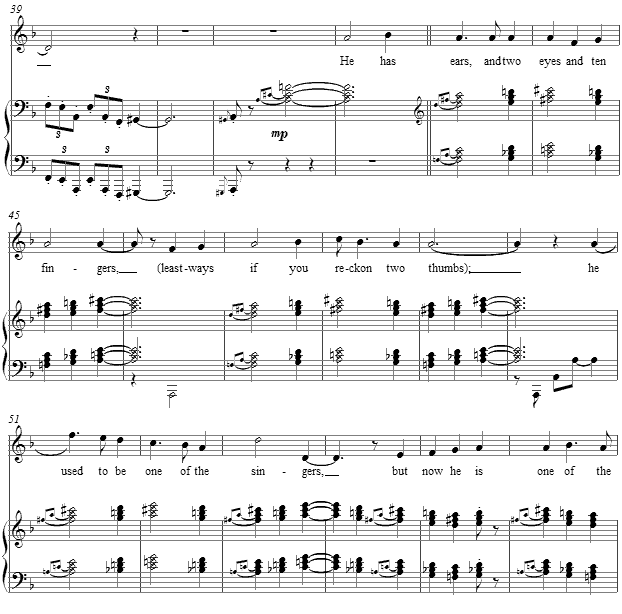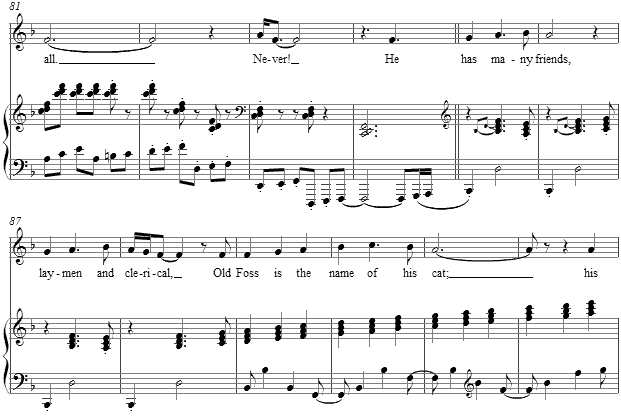Music and Texts of GARY BACHLUND
Vocal Music | Piano | Organ | Chamber Music | Orchestral | Articles and Commentary | Poems and Stories | Miscellany | FAQs
How pleasant to know Mr. Lear - (2008)
Edward Lear
for medium or high voice and piano
How pleasant to know Mr. Lear,
Who has written such volumes of stuff.
Some think him ill-tempered and queer,
But a few find him pleasant enough.
His mind is concrete and fastidious,
His nose is remarkably big;
His visage is more or less hideous,
His beard it resembles a wig.
He has ears, and two eyes, and ten fingers,
(Leastways if you reckon two thumbs);
He used to be one of the singers,
But now he is one of the dumbs.
He sits in a beautiful parlour,
With hundreds of books on the wall;
He drinks a great deal of marsala,
But never gets tipsy at all.
He has many friends, laymen and clerical,
Old Foss is the name of his cat;
His body is perfectly spherical,
He weareth a runcible hat. [ 1 ]
When he walks in waterproof white,
The children run after him so!
Calling out, "He's gone out in his night-
Gown, that crazy old Englishman, oh!"
He weeps by the side of the ocean,
He weeps on the top of the hill;
He purchases pancakes and lotion,
And chocolate shrimps from the mill.
He reads, but he does not speak, Spanish,
He cannot abide ginger beer;
Ere the days of his pilgrimage vanish,
How pleasant to know Mr. Lear![ 7 pages, circa 3' 20" ]
Edward Lear
Alongside my setting for Lear's The Pelican Chorus (2008) and the nine song settings for soprano collected together as "Calico Pie" and Other Nonsense (2002), I chose to savor these delightful words and images of Lear as his own literary self-portrait. We get to enjoy his good humor and not-quite-nonsense rhyme all the while learning a little something about his habits, preferences and even a taste of his oddly self-effacing braggadocio.
While the vocal range is not overly broad (intended for medium or high voice), the demand on the singer is one of salesmanship, as the shifting moods of each stanza demand. The opening stanza follows a short introduction in F, though the insistence on the raised fourth draws us away from a standard common-practice tonality.
The next stanza stresses the submediant minor, again with a raised fourth alongside a lowered sixth degree of that scale. As Lear shows us his less-than-godlike physical side, the colors and texture becomes more mysterious and dark.
The regions of F and D having been visited, it becomes time to wed the tonic and submediant together in a lightly polytonal parallelism.
After a revisit to the tonic, a verse then follows in the subdominant, again in parallel accompaniment structures.
Further reprises of the various tonal regions follow, though not in a wholly structured rondo or chain form. The setting ends with a repetition of the last line's "how pleasant" it is to know Mister Lear.
The score for How pleasant to know Mr. Lear is available as a free PDF download, though any major commercial performance or recording of the work is prohibited without prior arrangement with the composer. Click on the graphic below for this piano-vocal score.
NOTES
[ 1 ] Runcible -- a word coined by Lear for his well-known poem, "The Owl and the Pussycat," from 1871. It is defined humorously as "a forklike utensil with two broad prongs and one sharp curved prong" [Collins] and "a table utensil of indefinite form" [Webster's]. Other poets have occasionally borrowed the word, and the whole spectrum of nonsense poetry owes a debt of gratitude to such verbal coinage. In this particular use, using his own word as an adjective modifying the noun, "hat," shows just how indefinite and nonsensical Lear intended the word to be, since the more well-known and sometimes used phrase is "runcible spoon." Let us imagine a hat like a spoon and a spoon like a hat, and both with "two broad prongs and one sharp curved prong" all the while being of "indefinite form." Bonne chance!




